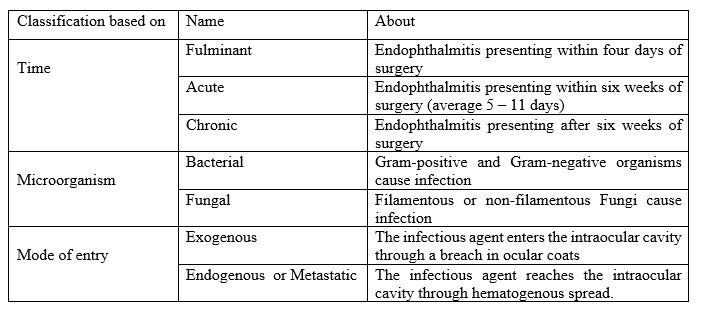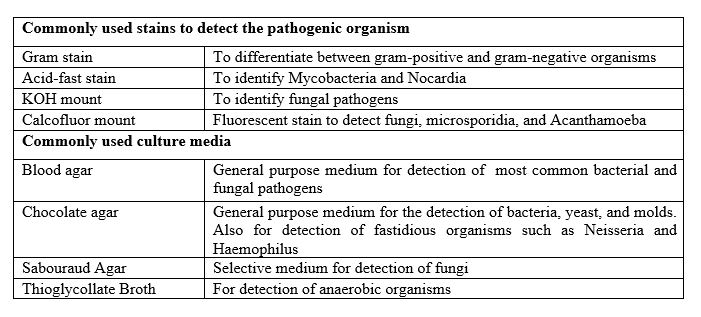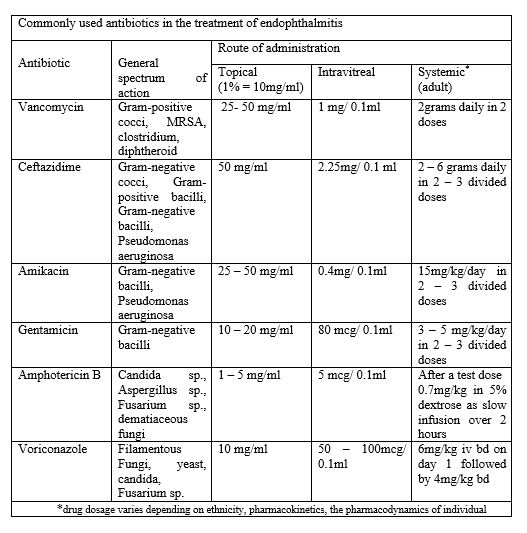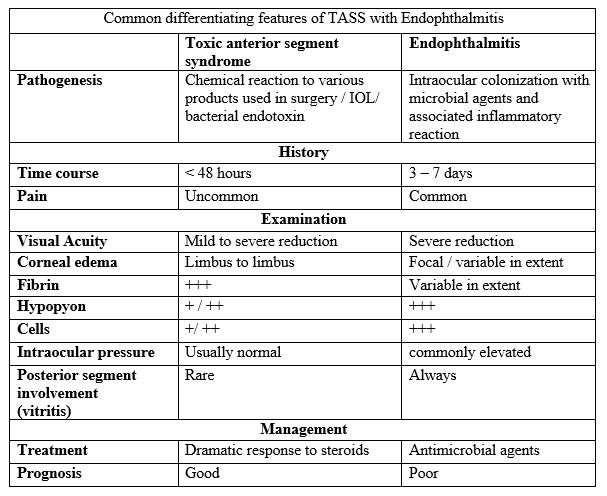[1]
Durand ML. Endophthalmitis. Clinical microbiology and infection : the official publication of the European Society of Clinical Microbiology and Infectious Diseases. 2013 Mar:19(3):227-34. doi: 10.1111/1469-0691.12118. Epub
[PubMed PMID: 23438028]
[2]
Sunaric-Mégevand G, Pournaras CJ. Current approach to postoperative endophthalmitis. The British journal of ophthalmology. 1997 Nov:81(11):1006-15
[PubMed PMID: 9505828]
[3]
Gentile RC, Shukla S, Shah M, Ritterband DC, Engelbert M, Davis A, Hu DN. Microbiological spectrum and antibiotic sensitivity in endophthalmitis: a 25-year review. Ophthalmology. 2014 Aug:121(8):1634-42. doi: 10.1016/j.ophtha.2014.02.001. Epub 2014 Apr 2
[PubMed PMID: 24702755]
[4]
Jonas JB, Knorr HL, Budde WM. Prognostic factors in ocular injuries caused by intraocular or retrobulbar foreign bodies. Ophthalmology. 2000 May:107(5):823-8
[PubMed PMID: 10811069]
[5]
Verma L, Chakravarti A. Prevention and management of postoperative endophthalmitis: A case-based approach. Indian journal of ophthalmology. 2017 Dec:65(12):1396-1402. doi: 10.4103/ijo.IJO_1058_17. Epub
[PubMed PMID: 29208820]
Level 3 (low-level) evidence
[6]
Maalouf F, Abdulaal M, Hamam RN. Chronic postoperative endophthalmitis: a review of clinical characteristics, microbiology, treatment strategies, and outcomes. International journal of inflammation. 2012:2012():313248. doi: 10.1155/2012/313248. Epub 2012 Feb 22
[PubMed PMID: 22550607]
[7]
Jacobs DJ, Leng T, Flynn HW Jr, Shi W, Miller D, Gedde SJ. Delayed-onset bleb-associated endophthalmitis: presentation and outcome by culture result. Clinical ophthalmology (Auckland, N.Z.). 2011:5():739-44. doi: 10.2147/OPTH.S17975. Epub 2011 Jun 2
[PubMed PMID: 21691583]
[8]
Gedde SJ, Scott IU, Tabandeh H, Luu KK, Budenz DL, Greenfield DS, Flynn HW Jr. Late endophthalmitis associated with glaucoma drainage implants. Ophthalmology. 2001 Jul:108(7):1323-7
[PubMed PMID: 11425695]
[9]
McCannel CA. Meta-analysis of endophthalmitis after intravitreal injection of anti-vascular endothelial growth factor agents: causative organisms and possible prevention strategies. Retina (Philadelphia, Pa.). 2011 Apr:31(4):654-61. doi: 10.1097/IAE.0b013e31820a67e4. Epub
[PubMed PMID: 21330939]
Level 1 (high-level) evidence
[10]
Chhablani J, Nayak S, Jindal A, Motukupally SR, Mathai A, Jalali S, Pappuru RR, Sharma S, Das T, Flynn HW Jr, Pathengay A. Scleral buckle infections: microbiological spectrum and antimicrobial susceptibility. Journal of ophthalmic inflammation and infection. 2013 Dec 13:3(1):67. doi: 10.1186/1869-5760-3-67. Epub 2013 Dec 13
[PubMed PMID: 24330530]
[11]
Rosenberg KD, Flynn HW Jr, Alfonso EC, Miller D. Fusarium endophthalmitis following keratitis associated with contact lenses. Ophthalmic surgery, lasers & imaging : the official journal of the International Society for Imaging in the Eye. 2006 Jul-Aug:37(4):310-3. doi: 10.3928/15428877-20060701-08. Epub
[PubMed PMID: 16898392]
[12]
Mulhern MG, Condon PI, O'Keefe M. Endophthalmitis after astigmatic myopic laser in situ keratomileusis. Journal of cataract and refractive surgery. 1997 Jul-Aug:23(6):948-50
[PubMed PMID: 9292683]
[13]
Wong JS, Chan TK, Lee HM, Chee SP. Endogenous bacterial endophthalmitis: an east Asian experience and a reappraisal of a severe ocular affliction. Ophthalmology. 2000 Aug:107(8):1483-91
[PubMed PMID: 10919895]
[14]
Chawla R, Venkatesh P, Garg SP, Tripathy K. Bilateral metastatic endophthalmitis due to Pseudomonas aeruginosa after vaginal delivery. Journal of obstetrics and gynaecology : the journal of the Institute of Obstetrics and Gynaecology. 2016 Nov:36(8):1016-1017
[PubMed PMID: 27750450]
[15]
Srujana D, Singh R, Tripathy K. Comment on "Surgical management of fungal endophthalmitis resulting from fungal keratitis". International journal of ophthalmology. 2017:10(9):1479-1480. doi: 10.18240/ijo.2017.09.24. Epub 2017 Sep 18
[PubMed PMID: 28944212]
Level 3 (low-level) evidence
[16]
Safneck JR. Endophthalmitis: A review of recent trends. Saudi journal of ophthalmology : official journal of the Saudi Ophthalmological Society. 2012 Apr:26(2):181-9. doi: 10.1016/j.sjopt.2012.02.011. Epub 2012 Mar 3
[PubMed PMID: 23960990]
[17]
Pershing S, Lum F, Hsu S, Kelly S, Chiang MF, Rich WL 3rd, Parke DW 2nd. Endophthalmitis after Cataract Surgery in the United States: A Report from the Intelligent Research in Sight Registry, 2013-2017. Ophthalmology. 2020 Feb:127(2):151-158. doi: 10.1016/j.ophtha.2019.08.026. Epub 2019 Aug 28
[PubMed PMID: 31611015]
[18]
Xu K, Chin EK, Bennett SR, Williams DF, Ryan EH, Dev S, Mittra RA, Quiram PA, Davies JB, Parke DW 3rd, Johnson JB, Cantrill HL, Almeida DRP. Endophthalmitis after Intravitreal Injection of Vascular Endothelial Growth Factor Inhibitors: Management and Visual Outcomes. Ophthalmology. 2018 Aug:125(8):1279-1286. doi: 10.1016/j.ophtha.2018.01.022. Epub 2018 Feb 21
[PubMed PMID: 29477689]
[19]
Thompson JT, Parver LM, Enger CL, Mieler WF, Liggett PE. Infectious endophthalmitis after penetrating injuries with retained intraocular foreign bodies. National Eye Trauma System. Ophthalmology. 1993 Oct:100(10):1468-74
[PubMed PMID: 8414406]
[20]
Thompson WS, Rubsamen PE, Flynn HW Jr, Schiffman J, Cousins SW. Endophthalmitis after penetrating trauma. Risk factors and visual acuity outcomes. Ophthalmology. 1995 Nov:102(11):1696-701
[PubMed PMID: 9098264]
[21]
Jabbarvand M, Hashemian H, Khodaparast M, Jouhari M, Tabatabaei A, Rezaei S. Endophthalmitis Occurring after Cataract Surgery: Outcomes of More Than 480 000 Cataract Surgeries, Epidemiologic Features, and Risk Factors. Ophthalmology. 2016 Feb:123(2):295-301. doi: 10.1016/j.ophtha.2015.08.023. Epub 2015 Dec 15
[PubMed PMID: 26704882]
[22]
Yao K, Zhu Y, Zhu Z, Wu J, Liu Y, Lu Y, Hao Y, Bao Y, Ye J, Huang Y, Li Z, Shentu X, Yu Y. The incidence of postoperative endophthalmitis after cataract surgery in China: a multicenter investigation of 2006-2011. The British journal of ophthalmology. 2013 Oct:97(10):1312-7. doi: 10.1136/bjophthalmol-2013-303282. Epub 2013 Jul 24
[PubMed PMID: 23884695]
[23]
Mithal K, Mathai A, Pathengay A, Jalali S, Relhan N, Motukupally SR, Sharma S, Das T. Endophthalmitis following intravitreal anti-VEGF injections in ambulatory surgical centre facility: incidence, management and outcome. The British journal of ophthalmology. 2013 Dec:97(12):1609-12. doi: 10.1136/bjophthalmol-2013-303222. Epub 2013 Sep 24
[PubMed PMID: 24064940]
[24]
Falavarjani KG, Modarres M, Hashemi M, Parvaresh MM, Naseripour M, Zare-Moghaddam A, Nekoozadeh S. Incidence of acute endophthalmitis after intravitreal bevacizumab injection in a single clinical center. Retina (Philadelphia, Pa.). 2013 May:33(5):971-4. doi: 10.1097/IAE.0b013e31826f0675. Epub
[PubMed PMID: 23400076]
[25]
Aaberg TM Jr, Flynn HW Jr, Schiffman J, Newton J. Nosocomial acute-onset postoperative endophthalmitis survey. A 10-year review of incidence and outcomes. Ophthalmology. 1998 Jun:105(6):1004-10
[PubMed PMID: 9627649]
Level 3 (low-level) evidence
[26]
Wolner B, Liebmann JM, Sassani JW, Ritch R, Speaker M, Marmor M. Late bleb-related endophthalmitis after trabeculectomy with adjunctive 5-fluorouracil. Ophthalmology. 1991 Jul:98(7):1053-60
[PubMed PMID: 1891213]
[27]
Kumar A, Tripathy K, Chawla R. Intraocular use of bevacizumab in India: An issue resolved? The National medical journal of India. 2017 Nov-Dec:30(6):345-347. doi: 10.4103/0970-258X.239079. Epub
[PubMed PMID: 30117450]
[28]
Pilli S, Kotsolis A, Spaide RF, Slakter J, Freund KB, Sorenson J, Klancnik J, Cooney M. Endophthalmitis associated with intravitreal anti-vascular endothelial growth factor therapy injections in an office setting. American journal of ophthalmology. 2008 May:145(5):879-82. doi: 10.1016/j.ajo.2007.12.036. Epub 2008 Mar 10
[PubMed PMID: 18329624]
[29]
Khan P,Khan L,Mondal P, Cluster endophthalmitis following multiple intravitreal bevacizumab injections from a single use vial. Indian journal of ophthalmology. 2016 Sep
[PubMed PMID: 27853027]
[30]
Gonzalez S, Rosenfeld PJ, Stewart MW, Brown J, Murphy SP. Avastin doesn't blind people, people blind people. American journal of ophthalmology. 2012 Feb:153(2):196-203.e1. doi: 10.1016/j.ajo.2011.11.023. Epub
[PubMed PMID: 22264942]
[31]
Carlson AN, Koch DD. Endophthalmitis following Nd:YAG laser posterior capsulotomy. Ophthalmic surgery. 1988 Mar:19(3):168-70
[PubMed PMID: 3258419]
[32]
Callegan MC, Jett BD, Hancock LE, Gilmore MS. Role of hemolysin BL in the pathogenesis of extraintestinal Bacillus cereus infection assessed in an endophthalmitis model. Infection and immunity. 1999 Jul:67(7):3357-66
[PubMed PMID: 10377113]
[33]
Jett BD, Jensen HG, Nordquist RE, Gilmore MS. Contribution of the pAD1-encoded cytolysin to the severity of experimental Enterococcus faecalis endophthalmitis. Infection and immunity. 1992 Jun:60(6):2445-52
[PubMed PMID: 1587612]
[34]
Ng EW, Costa JR, Samiy N, Ruoff KL, Connolly E, Cousins FV, D'Amico DJ. Contribution of pneumolysin and autolysin to the pathogenesis of experimental pneumococcal endophthalmitis. Retina (Philadelphia, Pa.). 2002 Oct:22(5):622-32
[PubMed PMID: 12441729]
[35]
Hunt JJ, Astley R, Wheatley N, Wang JT, Callegan MC. TLR4 contributes to the host response to Klebsiella intraocular infection. Current eye research. 2014 Aug:39(8):790-802. doi: 10.3109/02713683.2014.883412. Epub 2014 Mar 3
[PubMed PMID: 24588082]
[36]
Callegan MC, Booth MC, Jett BD, Gilmore MS. Pathogenesis of gram-positive bacterial endophthalmitis. Infection and immunity. 1999 Jul:67(7):3348-56
[PubMed PMID: 10377112]
[37]
Callegan MC, Kane ST, Cochran DC, Novosad B, Gilmore MS, Gominet M, Lereclus D. Bacillus endophthalmitis: roles of bacterial toxins and motility during infection. Investigative ophthalmology & visual science. 2005 Sep:46(9):3233-8
[PubMed PMID: 16123424]
[38]
Petropoulos IK, Vantzou CV, Lamari FN, Karamanos NK, Anastassiou ED, Pharmakakis NM. Expression of TNF-alpha, IL-1beta, and IFN-gamma in Staphylococcus epidermidis slime-positive experimental endophthalmitis is closely related to clinical inflammatory scores. Graefe's archive for clinical and experimental ophthalmology = Albrecht von Graefes Archiv fur klinische und experimentelle Ophthalmologie. 2006 Oct:244(10):1322-8
[PubMed PMID: 16544114]
[39]
Scott IU, Flynn HW Jr, Dev S, Shaikh S, Mittra RA, Arevalo JF, Kychenthal A, Acar N. Endophthalmitis after 25-gauge and 20-gauge pars plana vitrectomy: incidence and outcomes. Retina (Philadelphia, Pa.). 2008 Jan:28(1):138-42. doi: 10.1097/IAE.0b013e31815e9313. Epub
[PubMed PMID: 18185150]
[40]
. Results of the Endophthalmitis Vitrectomy Study. A randomized trial of immediate vitrectomy and of intravenous antibiotics for the treatment of postoperative bacterial endophthalmitis. Endophthalmitis Vitrectomy Study Group. Archives of ophthalmology (Chicago, Ill. : 1960). 1995 Dec:113(12):1479-96
[PubMed PMID: 7487614]
Level 1 (high-level) evidence
[41]
Endophthalmitis Study Group, European Society of Cataract & Refractive Surgeons. Prophylaxis of postoperative endophthalmitis following cataract surgery: results of the ESCRS multicenter study and identification of risk factors. Journal of cataract and refractive surgery. 2007 Jun:33(6):978-88
[PubMed PMID: 17531690]
Level 2 (mid-level) evidence
[42]
Miller JJ, Scott IU, Flynn HW Jr, Smiddy WE, Murray TG, Berrocal A, Miller D. Endophthalmitis caused by Bacillus species. American journal of ophthalmology. 2008 May:145(5):883-8. doi: 10.1016/j.ajo.2007.12.026. Epub 2008 Mar 4
[PubMed PMID: 18295182]
[43]
Bhagat N, Nagori S, Zarbin M. Post-traumatic Infectious Endophthalmitis. Survey of ophthalmology. 2011 May-Jun:56(3):214-51. doi: 10.1016/j.survophthal.2010.09.002. Epub 2011 Mar 12
[PubMed PMID: 21397289]
Level 3 (low-level) evidence
[44]
Deramo VA, Ting TD. Treatment of Propionibacterium acnes endophthalmitis. Current opinion in ophthalmology. 2001 Jun:12(3):225-9
[PubMed PMID: 11389352]
Level 3 (low-level) evidence
[45]
Samson CM, Foster CS. Chronic postoperative endophthalmitis. International ophthalmology clinics. 2000 Winter:40(1):57-67
[PubMed PMID: 10713914]
[46]
Venkatesh P, Temkar S, Tripathy K, Chawla R. Intralesional antibiotic injection using 41G needle for the management of subretinal abscess in endogenous endophthalmitis. International journal of retina and vitreous. 2016:2():17
[PubMed PMID: 27847635]
[47]
Sridhar J, Flynn HW Jr, Kuriyan AE, Miller D, Albini T. Endogenous fungal endophthalmitis: risk factors, clinical features, and treatment outcomes in mold and yeast infections. Journal of ophthalmic inflammation and infection. 2013 Sep 20:3(1):60. doi: 10.1186/1869-5760-3-60. Epub 2013 Sep 20
[PubMed PMID: 24053550]
[48]
Tripathy K, Chawla R, Venkatesh P, Sharma YR, Vohra R. Ultrawide Field Imaging in Uveitic Non-dilating Pupils. Journal of ophthalmic & vision research. 2017 Apr-Jun:12(2):232-233. doi: 10.4103/2008-322X.205360. Epub
[PubMed PMID: 28540019]
[49]
Tripathy K, Chawla R, Vohra R. Evaluation of the fundus in poorly dilating diabetic pupils using ultrawide field imaging. Clinical & experimental optometry. 2017 Nov:100(6):735-736. doi: 10.1111/cxo.12484. Epub 2016 Oct 5
[PubMed PMID: 27704602]
[50]
Barza M, Pavan PR, Doft BH, Wisniewski SR, Wilson LA, Han DP, Kelsey SF. Evaluation of microbiological diagnostic techniques in postoperative endophthalmitis in the Endophthalmitis Vitrectomy Study. Archives of ophthalmology (Chicago, Ill. : 1960). 1997 Sep:115(9):1142-50
[PubMed PMID: 9298055]
[51]
Cornut PL, Boisset S, Romanet JP, Maurin M, Carricajo A, Benito Y, Vandenesch F, Chiquet C. Principles and applications of molecular biology techniques for the microbiological diagnosis of acute post-operative endophthalmitis. Survey of ophthalmology. 2014 May-Jun:59(3):286-303. doi: 10.1016/j.survophthal.2013.08.002. Epub 2013 Dec 18
[PubMed PMID: 24359808]
Level 3 (low-level) evidence
[52]
Lott MN, Fuller JJ, Hancock HA, Singh J, Singh H, McGwin G Jr, Marcus DM. Vitreal penetration of oral moxifloxacin in humans. Retina (Philadelphia, Pa.). 2008 Mar:28(3):473-6. doi: 10.1097/IAE.0b013e31814fb0ed. Epub
[PubMed PMID: 18327141]
[53]
Brockhaus L, Goldblum D, Eggenschwiler L, Zimmerli S, Marzolini C. Revisiting systemic treatment of bacterial endophthalmitis: a review of intravitreal penetration of systemic antibiotics. Clinical microbiology and infection : the official publication of the European Society of Clinical Microbiology and Infectious Diseases. 2019 Nov:25(11):1364-1369. doi: 10.1016/j.cmi.2019.01.017. Epub 2019 Feb 14
[PubMed PMID: 30771529]
[54]
Jackson TL, Eykyn SJ, Graham EM, Stanford MR. Endogenous bacterial endophthalmitis: a 17-year prospective series and review of 267 reported cases. Survey of ophthalmology. 2003 Jul-Aug:48(4):403-23
[PubMed PMID: 12850229]
Level 3 (low-level) evidence
[55]
Shirodkar AR, Pathengay A, Flynn HW Jr. Intravitreal gentamicin-induced macular infarction: SD-OCT features. Ophthalmic surgery, lasers & imaging : the official journal of the International Society for Imaging in the Eye. 2011 Aug 4:42 Online():e67-70. doi: 10.3928/15428877-20110728-01. Epub 2011 Aug 4
[PubMed PMID: 21805955]
[56]
Luaces-Rodríguez A, González-Barcia M, Blanco-Teijeiro MJ, Gil-Martínez M, Gonzalez F, Gómez-Ulla F, Lamas MJ, Otero-Espinar FJ, Fernández-Ferreiro A. Review of Intraocular Pharmacokinetics of Anti-Infectives Commonly Used in the Treatment of Infectious Endophthalmitis. Pharmaceutics. 2018 May 29:10(2):. doi: 10.3390/pharmaceutics10020066. Epub 2018 May 29
[PubMed PMID: 29844284]
[57]
Pathengay A, Mathai A, Shah GY, Ambatipudi S. Intravitreal piperacillin/tazobactam in the management of multidrug-resistant Pseudomonas aeruginosa endophthalmitis. Journal of cataract and refractive surgery. 2010 Dec:36(12):2210-1. doi: 10.1016/j.jcrs.2010.09.013. Epub
[PubMed PMID: 21111328]
[58]
Loewenstein A, Zemel E, Lazar M, Perlman I. Drug-induced retinal toxicity in albino rabbits: the effects of imipenem and aztreonam. Investigative ophthalmology & visual science. 1993 Nov:34(12):3466-76
[PubMed PMID: 8225881]
[59]
Barza M, Kane A, Baum J. Pharmacokinetics of intravitreal carbenicillin, cefazolin, and gentamicin in rhesus monkeys. Investigative ophthalmology & visual science. 1983 Dec:24(12):1602-6
[PubMed PMID: 6654640]
[61]
Radhika M, Mithal K, Bawdekar A, Dave V, Jindal A, Relhan N, Albini T, Pathengay A, Flynn HW. Pharmacokinetics of intravitreal antibiotics in endophthalmitis. Journal of ophthalmic inflammation and infection. 2014:4():22. doi: 10.1186/s12348-014-0022-z. Epub 2014 Sep 10
[PubMed PMID: 25667683]
[62]
Jacobs DJ, Grube TJ, Flynn HW Jr, Greven CM, Pathengay A, Miller D, Sanke RF, Thorman J. Intravitreal moxifloxacin in the management of Ochrobactrum intermedium endophthalmitis due to metallic intraocular foreign body. Clinical ophthalmology (Auckland, N.Z.). 2013:7():1727-30. doi: 10.2147/OPTH.S44212. Epub 2013 Aug 27
[PubMed PMID: 24039392]
[63]
Samant P, Ramugade S. Successful use of intravitreal and systemic colistin in treating multidrug resistant Pseudomonas aeruginosa post-operative endophthalmitis. Indian journal of ophthalmology. 2014 Dec:62(12):1167-70. doi: 10.4103/0301-4738.126991. Epub
[PubMed PMID: 25579363]
[64]
Kuhn F, Gini G. Ten years after... are findings of the Endophthalmitis Vitrectomy Study still relevant today? Graefe's archive for clinical and experimental ophthalmology = Albrecht von Graefes Archiv fur klinische und experimentelle Ophthalmologie. 2005 Dec:243(12):1197-9
[PubMed PMID: 16136321]
[65]
Bui DK, Carvounis PE. Evidence for and against intravitreous corticosteroids in addition to intravitreous antibiotics for acute endophthalmitis. International ophthalmology clinics. 2014 Spring:54(2):215-24. doi: 10.1097/IIO.0000000000000020. Epub
[PubMed PMID: 24613894]
[66]
Das T, Dogra MR, Gopal L, Jalali S, Kumar A, Malpani A, Natarajan S, Rajeev B, Sharma S. Postsurgical endophthalmitis: diagnosis and management. Indian journal of ophthalmology. 1995 Sep:43(3):103-16
[PubMed PMID: 8822484]
[67]
Ciulla TA,Starr MB,Masket S, Bacterial endophthalmitis prophylaxis for cataract surgery: an evidence-based update. Ophthalmology. 2002 Jan
[PubMed PMID: 11772573]
[68]
Barry P, Seal DV, Gettinby G, Lees F, Peterson M, Revie CW, ESCRS Endophthalmitis Study Group. ESCRS study of prophylaxis of postoperative endophthalmitis after cataract surgery: Preliminary report of principal results from a European multicenter study. Journal of cataract and refractive surgery. 2006 Mar:32(3):407-10
[PubMed PMID: 16631047]
Level 2 (mid-level) evidence
[69]
Haripriya A, Chang DF, Namburar S, Smita A, Ravindran RD. Efficacy of Intracameral Moxifloxacin Endophthalmitis Prophylaxis at Aravind Eye Hospital. Ophthalmology. 2016 Feb:123(2):302-308. doi: 10.1016/j.ophtha.2015.09.037. Epub 2015 Oct 30
[PubMed PMID: 26522705]
[70]
Haripriya A, Chang DF, Ravindran RD. Endophthalmitis reduction with intracameral moxifloxacin in eyes with and without surgical complications: Results from 2 million consecutive cataract surgeries. Journal of cataract and refractive surgery. 2019 Sep:45(9):1226-1233. doi: 10.1016/j.jcrs.2019.04.018. Epub 2019 Jul 29
[PubMed PMID: 31371152]
[71]
Kim EA, Law SK, Coleman AL, Nouri-Mahdavi K, Giaconi JA, Yu F, Lee JW, Caprioli J. Long-Term Bleb-Related Infections After Trabeculectomy: Incidence, Risk Factors, and Influence of Bleb Revision. American journal of ophthalmology. 2015 Jun:159(6):1082-91. doi: 10.1016/j.ajo.2015.03.001. Epub 2015 Mar 5
[PubMed PMID: 25748577]
[72]
Witkin AJ, Shah AR, Engstrom RE, Kron-Gray MM, Baumal CR, Johnson MW, Witkin DI, Leung J, Albini TA, Moshfeghi AA, Batlle IR, Sobrin L, Eliott D. Postoperative Hemorrhagic Occlusive Retinal Vasculitis: Expanding the Clinical Spectrum and Possible Association with Vancomycin. Ophthalmology. 2015 Jul:122(7):1438-51. doi: 10.1016/j.ophtha.2015.03.016. Epub 2015 Apr 15
[PubMed PMID: 25886796]
[73]
Brynskov T, Kemp H, Sørensen TL. No cases of endophthalmitis after 20,293 intravitreal injections in an operating room setting. Retina (Philadelphia, Pa.). 2014 May:34(5):951-7. doi: 10.1097/IAE.0000000000000071. Epub
[PubMed PMID: 24317292]
Level 3 (low-level) evidence
[74]
Garg SJ, Dollin M, Hsu J, Storey P, Vander JF. Effect of a Strict 'No-Talking' Policy During Intravitreal Injection on Post-Injection Endophthalmitis. Ophthalmic surgery, lasers & imaging retina. 2015 Nov-Dec:46(10):1028-34. doi: 10.3928/23258160-20151027-07. Epub
[PubMed PMID: 26599245]
[75]
Narang S, Gupta V, Gupta A, Dogra MR, Pandav SS, Das S. Role of prophylactic intravitreal antibiotics in open globe injuries. Indian journal of ophthalmology. 2003 Mar:51(1):39-44
[PubMed PMID: 12701861]
[76]
Soheilian M, Rafati N, Mohebbi MR, Yazdani S, Habibabadi HF, Feghhi M, Shahriary HA, Eslamipour J, Piri N, Peyman GA, Traumatic Endophthalmitis Trial Research Group. Prophylaxis of acute posttraumatic bacterial endophthalmitis: a multicenter, randomized clinical trial of intraocular antibiotic injection, report 2. Archives of ophthalmology (Chicago, Ill. : 1960). 2007 Apr:125(4):460-5
[PubMed PMID: 17420365]
Level 1 (high-level) evidence
[77]
Park CY, Lee JK, Chuck RS. Toxic anterior segment syndrome-an updated review. BMC ophthalmology. 2018 Oct 25:18(1):276. doi: 10.1186/s12886-018-0939-3. Epub 2018 Oct 25
[PubMed PMID: 30359246]
[78]
Driebe WT Jr, Mandelbaum S, Forster RK, Schwartz LK, Culbertson WW. Pseudophakic endophthalmitis. Diagnosis and management. Ophthalmology. 1986 Apr:93(4):442-8
[PubMed PMID: 3486397]
[79]
Yamamoto T, Kuwayama Y, Nomura E, Tanihara H, Mori K, Japan Glaucoma Society Survey of Bleb-related Infection. Changes in visual acuity and intra-ocular pressure following bleb-related infection: the Japan Glaucoma Society Survey of Bleb-related Infection Report 2. Acta ophthalmologica. 2013 Sep:91(6):e420-6. doi: 10.1111/aos.12079. Epub 2013 Jul 2
[PubMed PMID: 23819592]
Level 3 (low-level) evidence
[80]
Shen X, Xu G. Vitrectomy for endogenous fungal endophthalmitis. Ocular immunology and inflammation. 2009 May-Jun:17(3):148-52. doi: 10.1080/09273940802689396. Epub
[PubMed PMID: 19585356]
[81]
Das T, Choudhury K, Sharma S, Jalali S, Nuthethi R, Endophthalmitis Research Group. Clinical profile and outcome in Bacillus endophthalmitis. Ophthalmology. 2001 Oct:108(10):1819-25
[PubMed PMID: 11581055]
[82]
Irvine WD, Flynn HW Jr, Miller D, Pflugfelder SC. Endophthalmitis caused by gram-negative organisms. Archives of ophthalmology (Chicago, Ill. : 1960). 1992 Oct:110(10):1450-4
[PubMed PMID: 1417545]
[83]
Chakrabarti A, Shivaprakash MR, Singh R, Tarai B, George VK, Fomda BA, Gupta A. Fungal endophthalmitis: fourteen years' experience from a center in India. Retina (Philadelphia, Pa.). 2008 Nov-Dec:28(10):1400-7
[PubMed PMID: 19009680]
[84]
Nicoară SD, Irimescu I, Călinici T, Cristian C. Outcome and Prognostic Factors for Traumatic Endophthalmitis over a 5-Year Period. Journal of ophthalmology. 2014:2014():747015. doi: 10.1155/2014/747015. Epub 2014 Sep 15
[PubMed PMID: 25302113]
[85]
Lu X, Ng DS, Zheng K, Peng K, Jin C, Xia H, Chen W, Chen H. Risk factors for endophthalmitis requiring evisceration or enucleation. Scientific reports. 2016 Jun 15:6():28100. doi: 10.1038/srep28100. Epub 2016 Jun 15
[PubMed PMID: 27302573]




